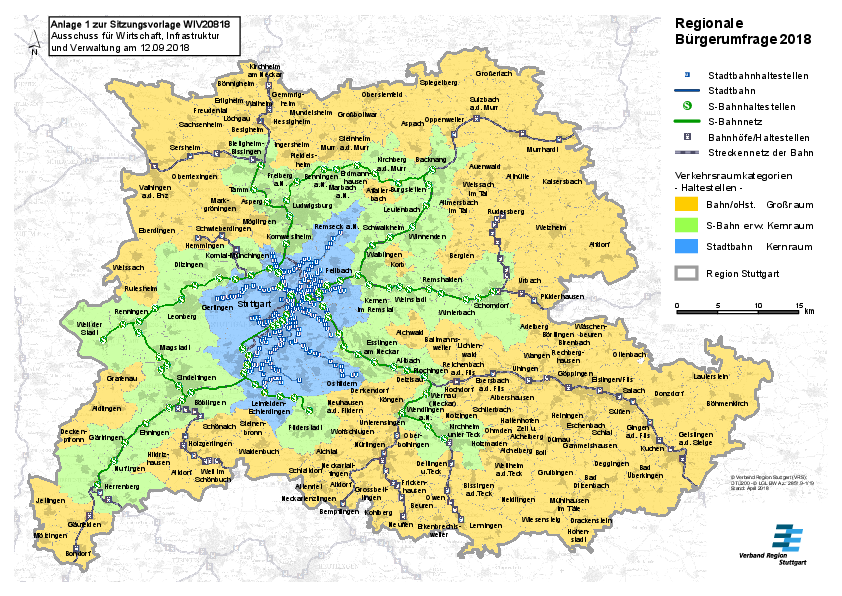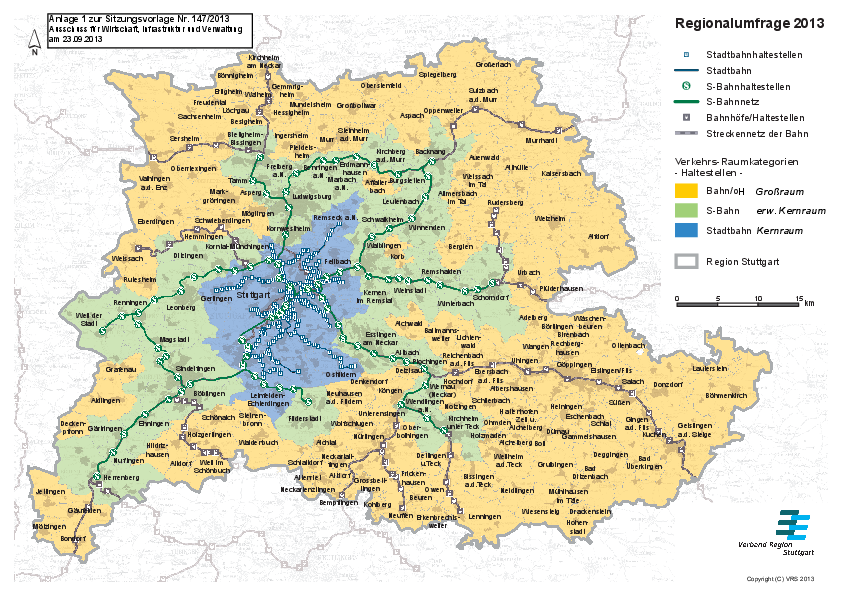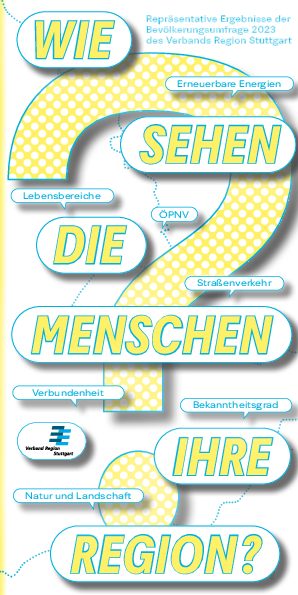Results of the 2023 population survey
Together with Forschungsgruppe Wahlen Telefonfeld GmbH (FGW), the Verband Region Stuttgart conducted a third telephone population survey in March 2023 after 2013 and 2018, in which 1,415 people took part. The questionnaire was largely retained in order to ensure good comparability and to obtain well-founded information on the changes over the past five years. The most important areas of responsibility of the Verband Region Stuttgart as well as regional topics are examined. Among other things, the quality of life and solidarity with the region, satisfaction with individual areas of life, public transport use, the topics of wind power and regional planning as well as the region's competencies are surveyed. A new question on the topic of future development was included in the survey.
Spatial categories were defined to reflect differences within the region. The results can thus be differentiated according to three municipality size categories (city of Stuttgart, municipalities with over 20,000 inhabitants, municipalities with less than 20,000 inhabitants), as well as according to three functional spatial categories based on rail accessibility (core area = municipalities on the Stuttgart light rail network, S-Bahn ring = municipalities on the S-Bahn network outside the core area, outer ring = municipalities outside the S-Bahn network).
How do you rate the quality of life in the Stuttgart region, how satisfied are you with public transport or the housing market, how do you rate the development of vacant land? The interviews were based on an extensive questionnaire on these and many other topics.

People in the Stuttgart Region still like nature and the countryside best. Similar to 2018, 41% put this in first place. The third regional population survey also shows that public transport, the road network and affordable housing are clearly identified as regional fields of action. With a strong increase of 16%, public transport is now in first place among the most important problems in the Stuttgart region. The importance of price as the main factor for public transport use has decreased. In the core area, 51% prefer lower prices, while in the outer ring a higher frequency is considered equally important. Road transport is in second place with 34%, a decrease of 11 percentage points. The housing market was rated as poorly as in 2018, with 79% of respondents rating it as less good or not good at all.
Approval of wind turbines reached an all-time high, particularly among younger age groups. Satisfaction with internet speed has also risen significantly and now stands at 71%. Attachment to the region has reached an all-time high of 61%, with 93% of respondents rating the quality of life in the Stuttgart Region as very good or good. The willingness to build on vacant land still does not find a majority - regardless of the intended use. Compared to the last survey, approval of building on vacant land for new railroad areas rose by a clear 8 percentage points to 46%. But here too, 47% are against it.
Here you can find the results report with graphical representations and here the detailed results table with all individual results and correlations .
Population survey from 2018

The second regional population survey showed that the topics of road traffic/local public transport, air quality and affordable housing were clearly identified as "regional problem areas". Respondents primarily saw improvements to local public transport as a helpful measure to improve air quality in the region, while restrictive measures such as driving bans were rejected by the majority. 86% of respondents said that it was difficult or very difficult to find affordable housing where they live. When asked about regional cooperation, the desire for more joint, regional regulation in the areas of transport (by 9 percentage points) increased to 65% and land planning (by 6 percentage points) to 47%. At the same time, however, there was a majority rejection of building on vacant land for this purpose in all the areas surveyed, i.e. residential and commercial areas as well as road and rail routes.
Here you can find the summary of the results of the 2018 population survey.
Population survey from 2013

Here you can find the results of the 2013 population survey in the long version and in the short version.











